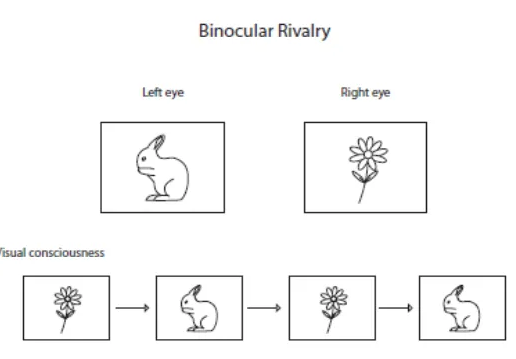CB7b
1/12
There's no tags or description
Looks like no tags are added yet.
Name | Mastery | Learn | Test | Matching | Spaced |
|---|
No study sessions yet.
13 Terms
The ventral stream hypothesis
NCCs of visual consciousness are located in areas along the ventral visual stream
Binocular rivalry studies
Monkeys saw two things at the same time and the brain were scanned.’
They checked how many of the cells changed during this process (%)

fMRI studies of human visual consciousness
They compared faces and places
Since the two is processed by different areas in the brain, they wanted to compare it.
Ventral stream is strengthen by these experiments
Victor Lamme’s Recurrent processing theory
It is a leading “early” theory of visual consciousness
Fast visual processing without consciousness = feedforward processing up to 100 ms after stimulus onset
Phenomenal Visual Consciousness = local recurrent processing in the ventral visual stream, 100-200 ms after stimulus onset
Access Consciousness, reportability = widespread (global) recurrent processing reaching also to the frontoparietal networks and working memory
Contrastive analysis
The DIFFERENCE in ERPs between a stimulus that enters consciousness and a similar stimulus that remains outside consciousness
How to make stimuli invisible for contrastive analysis?
above perceptual threshold vs below perceptual threshold stimulus
masked vs non-masked stimulus
Where and when does event-related activity correlate with the conscious perception of objects?
There was an early MEG study of conscious visual perception was to show the subject objects and non objects in different duration. The study tried to localize the source that correlates with visual consciousness. It showed that the Right later occipital cortex had something to do with it. Visual awareness negativity (VAN) is an ERP event that correlate of visual awareness was found at the same window as a MEG component.
Problem with event related acitivty
There is a physical difference between stimuli that enter consciousness vs remain nonconscious, and does the results hold for physically identical stimuli
They don't know if the difference was the time that they showed the stimuli or if it was the consciousness that acted
Is VAN the earliest correlate or is it P1?
According to Antti it is VAN, but there was some other scientists that have published that suggested P1. But when they tried to replicate it they got the result that it was WAN and not P1.
Works/fit well with ventral stream consciousness theory
VAN may be an indicator of the onset of phenomenal visual consciousness
The later positivity (LP) that also correlates with awareness of stimuli) may be an indicator of further, post-phenomenal conscious processing or reflective consciousness
The posterior “HOT ZONE” of NCC
States that the “visual consciousness” is located towards the back of the head
Global neuronal workspace theory
Is a leading “Late” theory of visual consciousness
It focus on:
Preconscious processing
Conscious Access (reportability)
And does not include phenomenal consciousness.
According to Victor Lama’s theory “preconscious” would be phenomenal consciousness
P3 = ERP NCC
P3 = late positivity
Peaks around 350 - 500 ms which is pretty late/slow from the stimuli happens to it actually enter consciousness
He (Haynes) states that we live in a world that is a third of a second late (high ping in league)